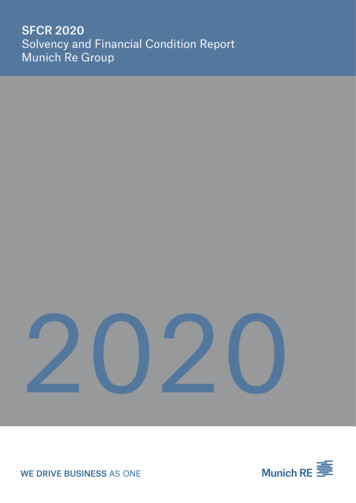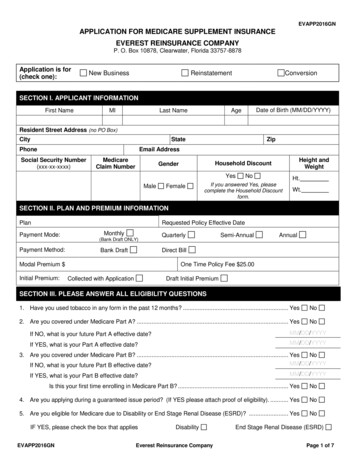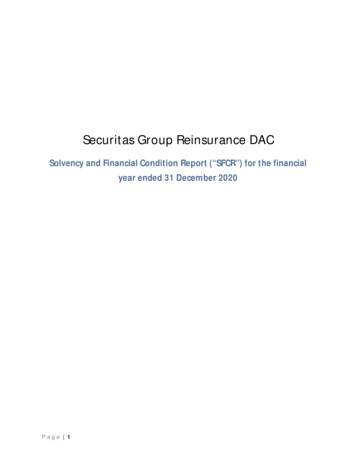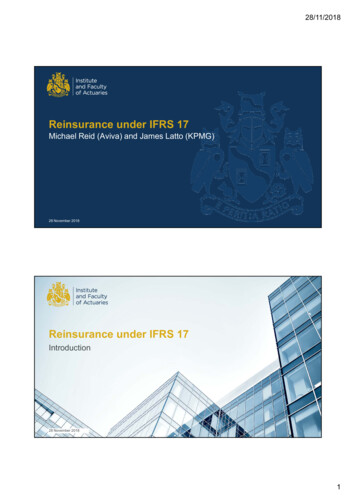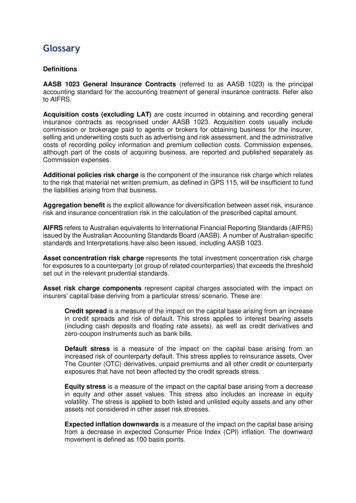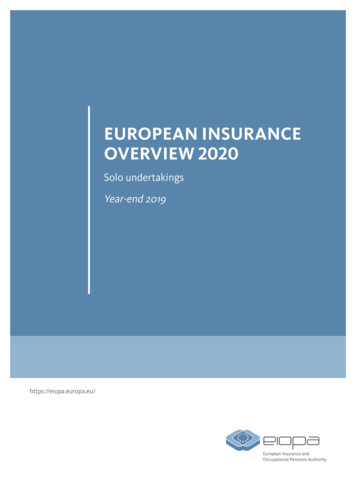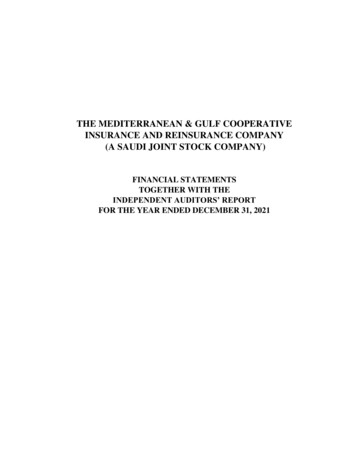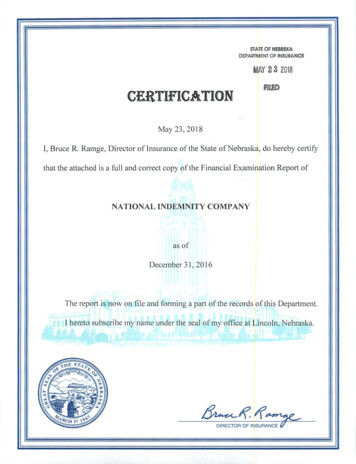
Transcription
INTRODUCTION TOINSURANCE AND REINSURANCECLAIMS MANAGEMENTSponsored byPrepared for Africa Re by theLONDONSCHOOL OFINSURANCEThe power of knowledge fitting the pieces togetherIntroduction to Insurance and Reinsurance Claims Management London School of Insurance 2017v2.1 - 20042017
INDEXSection 1INTRODUCTION.4A DEFINITION OF CLAIMS MANAGEMENT AND ITS ROLE INAN INSURANCE COMPANY.72.1 What is claims management?.72.2 What should be the underlying philosophy?.8Section 3A DEFINITION OF CLAIMS MANAGEMENT AND ITS ROLE IN AREINSURANCE COMPANY.93.1 What is claims management?.93.2 What should be the underlying philosophy?.9Section 4THE LEGAL POSITION.104.1 For an insurance company.104.2 For a reinsurance company.13Section 5CLAIMS ADMINISTRATION.155.1 For an insurance company.155.2 For a reinsurance company.16Section 6FACTORS DETERMINING THE VALIDITY OF A CLAIM.196.1 A review of the important aspects to determine coverageunder an insurance policy.196.2 A review of the important aspects to determine coverageunder a reinsurance contract.21Section 2CLAIMS NEGOTIATION, ADJUSTMENT, LITIGATION ANDPAYMENT.28Section 8PROCESSING NON-COMPLEX PROPERTY CLAIMS.308.1 Insurance aspects.308.2 Reinsurance aspects.31Section 9PROCESSING NON-COMPLEXLIABILITY CLAIMS.349.1 Insurance aspects.349.2 Reinsurance aspects.35Section 7Introduction to Insurance and Reinsurance Claims ManagementLONDONSCHOOL OFINSURANCEThe power of knowledge fitting the pieces together London School of Insurance 20172
Section 10DEALING WITH COMPLAINTS AND BAD FAITHACCUSATIONS.37OUTSOURCING.3911.1 Insurance aspects.3911.2 Reinsurance aspects.3911.3 Reviewing outsourcing needs.40Section 11Section 12CASE STUDY. 41Section 13CONCLUSION.45Section 14TEST.46Appendix A TEST ANSWERS. 47Appendix B NON PROPORTIONNAL REINSURANCE AGREEMENT. 48Appendix C COMBINED LIABILITY EXCESS OF LOSS REINSURANCEAGREEMENT. 82Appendix D STANDARD PROPERTY POLICY. 115Appendix E COMMERCIAL GENERAL LIABILITY COVERAGE FORM.132Introduction to Insurance and Reinsurance Claims ManagementLONDONSCHOOL OFINSURANCEThe power of knowledge fitting the pieces together London School of Insurance 20173
1. INTRODUCTIONEffective claims management is one of the most important activities in a successful insurance or reinsurancecompany.On the one hand by far the largest area of payment for an insurance or reinsurance company is claims, and bysavings through good claims management one can beneficially impact the profit and loss account to a much greaterextent than by savings in any other sector.On the other hand paying valid claims is what the insurance and reinsurance business is all about. However goodthe risk management of a client may be, claims are inevitable and this is why the insurance or reinsurance clientpurchased cover in the first place. Failure to honour the promise of cover in the event of a valid claim will not onlydamage the credibility of the company providing cover, but of the industry as well.Generally the aspect of paying claims is also the main focus of regulators – not only the ability, but also the willingness to pay claims. The easiest way to have problems with the regulator is to fail in this area of activity.If the above points are not entirely convincing, most smaller insurers and reinsurers rely on their ability to purchase cover from reinsurers and retrocessionaires respectively. If such companies cannot properly control theirlosses, they will be unable to obtain cover at an economic price, and without cover they will be unable to continuein business.This course “introduction to insurance and reinsurance claims management” is the sixth in a series ofcourses.It follows the first course “Introduction to Reinsurance” which was designed:-To provide you with an introduction to the world of reinsurance.To enable you to feel comfortable with, and understand, the core concepts and the principles.It follows the second course which was designed to provide you with the key elements of the practice of reinsurance:-An understanding of reinsurance documentationA knowledge of additional types of reinsurance cover not covered in course 1An understanding of reinsurance accountingAn understanding of statistics, incurred but not reported claims and risk profilesAn understanding of pricing methodsAn understanding of the reinsurance cycle.and a third course which set out the basic elements to enable you to design a reinsurance programme.It also follows the fourth course – “Basic Technical Reinsurance Accounting” – which covered the main vocabulary, items and processes required to understand and render the normal accounts required for non-proportional andproportional reinsurance treaties.Finally it follows the fifth course – “Advanced Technical Reinsurance Accounting” – which covered the morecomplex challenges which can be faced in technical reinsurance accounting including non-traditional and financialreinsurance contracts and as-if statistics.The reader of this course should have read at least the previous introductory courses prior to reading this manualand should be familiar with reinsurance terminology, forms and types of reinsurance and reinsurance documentation - all covered in previous courses.The objective of this course is to further enhance the knowledge gained by now covering claims.Introduction to Insurance and Reinsurance Claims ManagementLONDONSCHOOL OFINSURANCEThe power of knowledge fitting the pieces together London School of Insurance 20174
The main sections of this manual are as follows:Learning Objectives:Section 2 – A definition of claims management and its role in an insurance companyLearning objective: To have a clear understanding of what is claims management and its role in an insurance companySection 3 - A definition of claims management and its role in a reinsurance companyLearning objective: To have a clear understanding of what is claims management and its role in a reinsurancecompany.Section 4 – The legal positionLearning objective: To be able to appreciate the scope of legal issues that apply to claims management.Section 5 – Claims administrationLearning objective: Understanding the necessary claims processes to secure an efficient administration.Section 6 – Factors determining the validity of a claimLearning objective: To understand the process of vetting a claim and determining whether it is covered or not.Section 7 – Claims negotiation, adjustment, litigation and paymentLearning objective: To understand the basics of negotiating, litigating and adjusting claims including payment.Section 8 – Processing non-complex property claimsLearning objective: To be familiar with the processing of non-complex property claims.Section 9 – Processing non-complex liability claimsLearning objective: To be familiar with the processing of non-complex liability claims.Section 10 – Dealing with complaints and bad faith accusationsLearning objective: To be able to deal with complaints and bad faith accusations.Section 11 - OutsourcingLearning objective: To be able to review outsourcing needs.We hope this manual will provide you with the additional knowledge you will need to reach these goals, and willalso encourage your further research of this important aspect of insurance and reinsurance.Other manuals will soon be available to assist you with these further researches.Introduction to Insurance and Reinsurance Claims ManagementLONDONSCHOOL OFINSURANCEThe power of knowledge fitting the pieces together London School of Insurance 20175
2. A DEFINITION OF CLAIMS MANAGEMENT ANDITS ROLE IN AN INSURANCE COMPANYLearning objective: To have a clear understanding of what is claims management and its role in an insurance company.2.1What is claims management?The best advertisement a company can have is “we don’t advertise, we pay claims!”. Paying claims is the fulfilmentof the promise made in the policy issued to the client that they will not suffer in the event of a loss but be indemnifiedsuch that they will be in the same position after the loss as they were before the loss as far as financial compensationcan do this.This is the most important function of an insurance company in the eyes of the policyholder – support and promptpayment in the event of a loss.It should be noted at this point that a larger client may only have contact with an insurance company through, or incompany with, its broker. It may then be the broker who, in fact, has the main dealings with the insurance company.Nevertheless the broker will surely communicate any dissatisfaction with the insurance company to the client, thusthe reputation of the insurance company vis-a-vis the client remains very relevant.Often when a policyholder suffers a disaster they are desolate, they have no idea what to do or where to turn, andone of the first reactions will be to turn to their insurance provider. It may even be the first time they have properlyread their policy. The section headed “What to do in the event of a claim” can be the beginning of the road to repairand recovery, or it can be a nightmare adding insult to the disaster already suffered.Claims Management comprehends the processes and controls to provide an efficient and cost effective solution todeal with claims in the various classes of business underwritten by the company.Claims management starts with the content of “What to do in the event of a claim” in an insurance policy, andensures the policyholder can easily contact the company with the essential information they need to communicate,that they will be received – or the call will be answered – by a qualified person able to calm and guide them andintroduce them into a process that will give them the knowledge they will need to both minimise their losses andreceive the compensation due under the policy.Within the company claims management needs to ensure the right infrastructure exists, with qualified people, toprocess claims entered into the process. The claims team/department may also need access to other departments:to underwriters who have knowledge of the client, to the accounts department to ensure premiums have been paid,to higher management where decisions outside the process need to be made.Whether within the department or elsewhere, the claim should already be registered and the initial details recorded when the first contact was made by the client and an electronic or paper file opened. While the process willbe dealt with in more detail later in this manual, it will include:i.Reviewing the information supplied – has sufficient information been provided? Has a claim form alreadybeen completed? Are medical or police reports or provider estimates needed? Could fraud and/or sanctions be involved?ii.What is the cover under the policy and the sum insured?iii. What is the current estimated amount of the claim? Will it be necessary to inspect the loss? Will outsideexperts/adjusters be required? What process to arrange repairs and/or transport for policyholders?iv. Are third parties involved? Where does the liability for the loss appear to be – with an insured or a thirdparty? Is subrogation a possibility? Will outside legal assistance be required?Introduction to Insurance and Reinsurance Claims ManagementLONDONSCHOOL OFINSURANCEThe power of knowledge fitting the pieces together London School of Insurance 20176
2.2What should be the underlying philosophy?As stated earlier, from the policyholder’s point of view, a claim may be the only time the policyholder has a meaningful contact with the company. No other aspect of the company affairs, except its financial collapse or fraudulentdealings by its directors or management, is likely to be more damaging to its reputation than publications that it doesnot like to pay claims. Equally today with the internet and social media, policyholders wishing to complain about aninsurance company’s methods or attitudes when dealing with claims, can do so very quickly and effectively.Finally many countries today have an ombudsman. An ombudsman is an official, usually appointed independentlyby government, to officially investigate complaints against, amongst others, insurance companies. The ombudsmancan act as a mediator, but also can have meaningful powers to impose settlements, sanctions and fines.It therefore is only good business sense to promote, even show off, the claims department as a centre-piece ofthe company’s excellent services to policyholders and potential policyholders. The philosophy must be not only topromote the claims department, but to also make those excellent services a reality.Introduction to Insurance and Reinsurance Claims ManagementLONDONSCHOOL OFINSURANCEThe power of knowledge fitting the pieces together London School of Insurance 20177
3. A DEFINITION OF CLAIMS MANAGEMENT ANDITS ROLE IN A REINSURANCE COMPANYLearning objective: To have a clear understanding of what is claims management and its role in a reinsurancecompany.3.1What is claims management?As with an insurance company claims management comprehends the processes and controls to provide an efficient and cost effective solution to deal with claims in the various classes of business underwritten by the reinsurance company.Reputation for being willing and able to settle claims is equally important for a reinsurance company but thecontext is different.Firstly, a reinsurance company is much more likely to have had contact with the reinsured prior to paying claims,although it is also possible that all communication passes through the reinsurance intermediary.Secondly, when dealing with proportional treaties, the bulk of claims will be payable as an item in the quarterly orhalf yearly accounts rendered by the ceding company. In such cases it is only by exercising the “right of inspection”clause, or by requesting to make an audit, that the reinsurer can review individual claim files.Otherwise, it is only in cases of cash loss requests that any individual details of losses will be received, unless thetreaty is subject to bordereaux in this respect. However it may be that the ceding company refers particularly unusual or complex claims to its reinsurer for help and advice.Thirdly, claims under excess of loss treaties are likely to be large claims on individual risks or large claims resultingfrom catastrophe events and these require different investigation from the more local claims likely to be received byinsurance companies. This is not only a matter of size, but also location – possibly anywhere in the world, differentlanguages, different cultures, and different laws. Equally there are issues such as reinstatement clauses, currencyconversion clauses, stability/index clauses and hours clauses seldom used in local insurance policies. Sanctionsissues are also more difficult to control on an international level.Finally, there are issues such as claims co-operation and ex-gratia losses that need to be considered.3.2What should be the underlying philosophy?While social media, and ceding companies reaching out to regulators in foreign countries with possibly differentcultures and languages, may make reputational issues less important than for a local insurance company, nevertheless having a good reputation for solving claims problems and paying claims remains very important.Once again the philosophy must be to have qualified employees and good processes to provide high level andtimely services to ceding companies.When entering new markets due consideration must be given to all the legal, cultural, economic and linguisticissues. What are likely to be the challenges and costs when dealing with complex claims or disputes?Introduction to Insurance and Reinsurance Claims ManagementLONDONSCHOOL OFINSURANCEThe power of knowledge fitting the pieces together London School of Insurance 20178
4. THE LEGAL POSITIONLearning objective: To be able to appreciate the scope of legal issues that apply to claims management.4.1For an insurance company.An insurance company has to be knowledgeable in a number of legal areas. Firstly there are regulatory issues, secondly there are general legal issues, such as contract law, and thirdly there are laws more specific to insurers suchas the principle of indemnity and utmost good faith.Regulatory issues.Many jurisdictions require insurers to include clear wording in their policies of what an insured needs to do, andhow it needs to communicate with the insurance company, in the event of a claim. Such information should include:- The necessity that the insured report the claim as soon as possible. Some indication of timing may also be givento provide a guide of what the insurer expects. For example, in general claims should be reported within 3 workingdays.- If the insured is using the services of a broker that there is clarity with whom the insurer should be communicating.- Details of how the insured should communicate. Today there can be many forms of communication – by telephone, SMS, email, using a dedicated web site, or posting a letter. Each desired form should include full details ofhow to communicate – web site details, telephone numbers, and SMS contact details. Equally it should be definedwhich forms need to be completed and within what time frame, and whether this can be done online.- The necessity that the insured take all reasonable steps to minimise the loss and also to retain any evidence thatwill be important either for assessing coverage under the policy or calculating the amount of the loss.- That the insured clearly understands the obligation to help and facilitate the insurer in its investigation of theclaim, and that the insured understands legal concepts such as subrogation and its consequences, should the insurerdecide to exercise these legal rights.The regulator may also require the insurer to perform certain tasks within a defined time-frame.- The first obligation is generally to confirm to the insured or third party claimant receipt of the claim declaration, andto make clear to the insured/third party claimant what further information and/or completion of forms and/or evidenceis necessary to support the claims notification. Time frames vary from a few working days to one or two working weeks.- Once sufficient information has been received, there may be a time frame in which the insurer must investigatethe claim and advise the claimant whether coverage is accepted or denied. If coverage is denied, on what groundsit is being denied. If coverage is accepted, what are the next steps in the process and to indicate to the claimant thetime frame of the next steps. This time frame may be between two and four working weeks.- If the next steps involve sending an employee of the insurer, or a third party assessor to visit the claimant, thendetails of the process and time frame must be communicated to the claimant. Equally any delays in time framesprovided must be communicated to the claimant with reasons and a new time frame advised. This time frame maybe between two and four working weeks. However where complex injuries are involved, or the claim is for loss ofprofits, or litigation is involved, it may not be possible for the insurance company to control or have any influenceon time frames.- Once the insurance company has the necessary information to decide on quantum, there will generally be atime frame in which it is obliged to make an offer to the claimant, and equally a time frame to pay the claimant oncequantum has been agreed.Introduction to Insurance and Reinsurance Claims ManagementLONDONSCHOOL OFINSURANCEThe power of knowledge fitting the pieces together London School of Insurance 20179
The regulator may also dictate how claims are to be handled and managed.For example, the regulator may require the insurance company to produce a claims manual, and may specify someof the issues the manual must cover, for example, the claim process for the various classes of business in which theinsurance company operates. The regulator may also require time frames, explaining relevant insurance terminology to the claimant, keeping the claimant informed. Equally the regulator may also require to know how the processwill be audited and controlled and what minimum reporting standards may be required. The requirements may alsoinclude a minimum level of qualifications and training for the claims employees in the claims department and processes to prevent fraud. Possibly also to control fraud by making data available to databases which can be accessedby any insurance company in the marketplace.General legal issues.Insurance companies, like any other companies exercising a commercial activity, will be subject to the laws of theland, such as contract law, confidentiality, the ability to ask for and retain data, data storage, and exposure to accusations of negligence and bad faith.While contract and liability laws are likely to evolve at a more leisurely pace, laws around technology can evolverapidly especially regarding the use and storage of data, and the potentially costly consequences of data hackingand/or loss of data.Insurance specific legal issues.Insurable interest, utmost good faith, the principle of indemnity, subrogation and warranties.Insurable Interest:There was a period when, during the development of Lloyd’s of London, it was not clear whether transactions werebased on some sort of professional assessment of the risk, or were a pure gamble. This problem was not particularto Lloyd’s at the time, it was prevalent in many institutions offering covers at the time. The principle of insurableinterest was thus introduced as a prerequisite for any insurance contract to be effective to distinguish that contractfrom gambling. The United Kingdom was the first country to pass legislation that prohibited insurance contractsif no insurable interest existed. This requirement is contained in the Life Assurance Act of 1774 which renders lifeinsurance contracts illegal if there is no insurable interest, and the Marine Insurance Act 1906, s.4 which renderssuch contracts void.Thus the insured must have an “insurable interest” in the subject matter of the policy, or such policy will be voidand unenforceable as it will be considered gambling. An insured has an insurable interest in a policy when they canshow some type of financial benefit from the existence of the subject matter to be insured, or that they will suffer apecuniary loss from the loss of such subject matter should the risk covered by the insurance policy occur.Equally a reinsured must have an “insurable interest” in the subject matter of the reinsurance. If, for example, thereinsured wishes to obtain reinsurance to cover flooding in the centre of the country’s capital city, but it does nothave any risks there, then the reinsurance will be considered null and void. Thus, even if there is flooding at thatlocation, as the reinsured had no pecuniary interest in that location and cannot prove it suffered any loss from theoccurrence of the event it cannot make a claim under any reinsurance cover.It should also be noted that although Uzielli v. Boston Marine Insurance Co. (1884), 15 Q.B.D. 16. established thatan insurer has a potential liability under every subsisting policy that it has issued, and that it has an insurable interestin each risk, it is important to note in the “reinsurance” context that it’s interest is contingent upon the insured underthe original policy also having an interest in the subject-matter. Without such an insurable interest of the insured,both the insurance and the reinsurance are void.Utmost Good Faith:Given that the person or company who offers a risk for insurance or reinsurance knows, or should know, muchIntroduction to Insurance and Reinsurance Claims ManagementLONDONSCHOOL OFINSURANCEThe power of knowledge fitting the pieces together London School of Insurance 201710
more about that risk than the party willing to consider providing cover, it is natural that a greater degree of transparency should be expected than from a party to a simple commercial contract. Thus there is an obligation on theparty seeking the cover to disclose all material facts so that the contract will accurately reflect the actual risk(s) beingcovered. The principles underlying this rule were stated by Lord Mansfield in the leading case of Carter v Boehm(1766) 97 ER 1162, 1164:«Insurance is a contract of speculation. the special facts, upon which the contingent chance is to be computed,lie most commonly in the knowledge of the insured only: the underwriter trusts to his representation, and proceedsupon confidence that he does not keep back any circumstances in his knowledge, to mislead the underwriter into abelief that the circumstance does not exist. good faith forbids either party by concealing what he privately knows,to draw the other into a bargain from his ignorance of that fact, and his believing the contrary.”Equally therefore reinsurance contracts demand the same obligation and the principle of utmost good faith isconsidered the foundation of reinsurance as well. Essentially this means that the buyer of the cover (the insurancecompany or ceding company as it is known in reinsurance parlance), or its agent/intermediary, must honestly present the risk(s) to the seller (in this case the reinsurer) and can only make a valid claim if it has in fact suffered a loss.Thus if the ceding company hides material aspects of the risk(s) or falsely declares values, then it will be unable tosuccessfully recover a claim from the reinsurer.For example, if the ceding company/reinsured informs the reinsurer that it expects to cede a motor liability premium of 200,000 when it knows full well that it will likely cede in excess of 500,000, then it has misrepresentedthe facts to the prospective reinsurer, who will have the right to rescind/cancel the contract based on this misrepresentation.Indemnity:The principle of indemnity dictates that an insured or a reinsured should not profit from the cover it buys, butshould only be compensated for its actual loss, thus settlement depends on the terms of the contract and the realamount of loss suffered. With some covers, determining the real amount of the loss is relatively easy. It is impossibleto evaluate the worth of a human life and thus in life insurance the real amount of the loss is simply the face valueof the policy when the insured person dies. Under liability insurance the liability damages rendered in a judgementby the court and the proven legal costs are generally paid out, subject to the policy limit. Calculating the indemnityunder a property loss of profits cover can be very complex as it is often very difficult to prove what profit the insuredmight, or might not, have made had the loss not occurred. It must always be clear that moral hazard can occur ifan insured or a reinsured is allowed to make a profit out of a loss event, not only because such a situation is clearlyagainst public policy but also because it would materially increase the cost of obtaining cover. Equally an insured orreinsured cannot collect the same loss from multiple insurance policies or multiple reinsurance covers, even if theywere with different parties.Thus if the ceding company does not in fact itself have a real loss, then it has no right to make a claim against thereinsurer. For example, there is a large motor loss and the ceding company has to pay 250,000 to injured passengers, but it is able to recover that money in full from the insurer of the driver who was responsible for the accident,then it cannot also claim t
Within the company claims management needs to ensure the right infrastructure exists, with qualified people, to process claims entered into the process. The claims team/department may also need access to other departments: to underwriters who have knowledge of the client, to the accounts department to ensure premiums have been paid,

